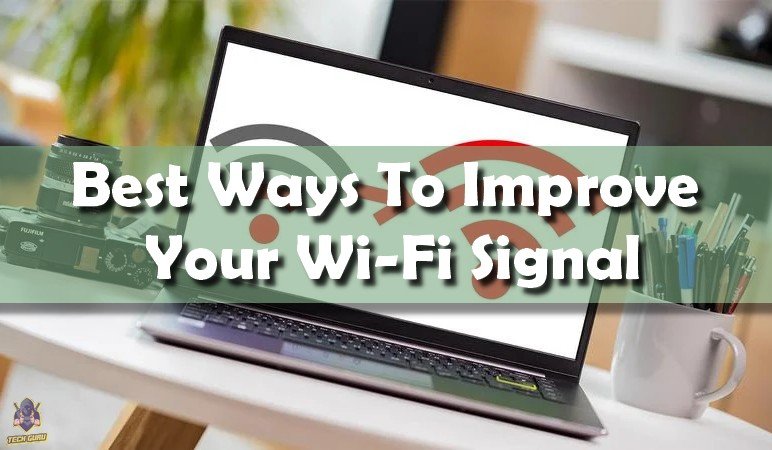If your want to improve your Wi-Fi signal, but you have no idea how to do that, here in this article, you can find the answer. You are tired of bad signal and slow internet, you want to download some good music or movie from the internet, but it takes an eternity to finish downloading, when you are in another room, the signal is bad and you want to break your router? Keep reading, and you will find out how to improve your Wi-Fi signal.
1. Restart Your Router
No one likes to hear it, but the old “did you try unplugging it and plugging it back in?” question is relevant here. Sometimes devices just need to reboot to apply updates and shut down software that isn’t running properly.

How to Fix Slow Wi-Fi By Restarting Your Router
First, if your router has a power button, use that to shut down your router. If there is no button, unplug the power cord. Leave the device unplugged or turned off for a few minutes.
Then, turn the device back on by pressing the power button again or plugging it back in. It will take a few minutes for the router to restart. You can monitor the progress by watching a few lights begin to light back up and blink. The router will be attempting to reconnect to the external IP address from your service provider.
After a few minutes, the lights should all be back to normal and you can reconnect your devices to the Wi-Fi.
2. Perform a Speed Test
Performing a speed test can help determine if your internet service is the problem rather than your equipment.
Performing a speed test with Ethernet cables will check the internet speed before it is ever converted to a wireless signal. If the test determines that your internet service is the root of the problem, you should follow up with your internet service provider.
Talk to your provider about your issues and see if they’re aware of any current problems that could be causing a lack of service. They might offer you an upgrade in your internet plan.
How to Perform a Speed Test
There are several websites you can use that will help you perform a speed test. You can use sites like Speedcheck, Speedtest, Speakeasy, and even the Google speed test. Providers also offer their own internet speed tests, including Xfinity, AT&T, and Spectrum.
Online speed tests will perform a speed test while you are connected to your Wi-Fi, but to test your internet service provider you should connect your device directly using an Ethernet cable. Wi-Fi connections can be limited by many factors, so first we want to test your fastest possible speed.
First, get an Ethernet cable and connect it to the Ethernet port in your wall. Connect the other end of the cable to your device. If your laptop doesn’t have an Ethernet port, you can use the USB Ethernet adapter to connect the cable to your laptop.
Then, run the test on your laptop using a speed test website and wait for the results. If your speed comes up as 5Mbps or lower, there is a serious issue with your provider. The average speed is 20 Mbps, and you should compare the speed in your results to the speed indicated by your plan.
3. Update Your Router Firmware
If your internet service provider isn’t the problem, it’s time to start troubleshooting your equipment. Another cause for slow internet could be your router.
Your router might be outdated and need firmware updates. Firmware updates are important because your router protects your internet connection from hackers. Without the necessary updates, your connection becomes vulnerable.
4. Boost Wi-Fi Signal With a Booster
Wi-Fi boosters are much like mesh systems because they boost your Wi-Fi signal. These devices are often also called Wi-Fi extenders or repeaters.
You can look into boosters from TP-Link, Netgear, or Linksys. Compare them based on whether they will block the outlets you need if you can afford them, and if they match the Wi-Fi standards that your router uses.
5. Set a Strong Password for Your Network
Your router does a good job of protecting your internet connection from malicious actors, but it’s only as strong as the password you provide. Just like you protect your bank account login or ATM codes, you should protect your Wi-Fi connection.
But what does it mean to provide a strong password?
First of all, you shouldn’t be using the most common and easy to guess passwords ever created. These passwords include phrases like “password” and “1234.”

You also shouldn’t use personal information that’s easy to get access to. Don’t use your name, address, pet’s name, or phone number. It might take a few tries, but anyone can easily gain access to your internet with a lucky guess.
A strong password includes a combination of uppercase and lowercase letters. It also includes special characters and numbers. These rules usually create a password that’s hard to remember, so you can write it down. Keep that information in a safe place, though, or it’s pointless to even have a password at all.
WPA2
WPA2 is an encryption method used for most Wi-Fi networks to help protect information that is transmitted through your connection. In the past, there have been some major vulnerabilities to this encryption method that has allowed attackers to gain access to stored information on your devices.
Along with a strong password, make sure you always update your router with the newest patches for vulnerabilities to keep your identity safe.


